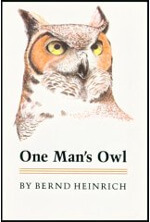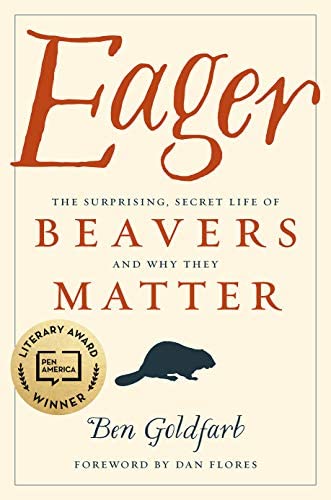With cold winter finally here, might be time for a book
Temperatures in the 50s and sap running in early January? An unsettling start to winter.
Even as folks hike in the mud or head up to the sugar house, animals are employing age-old behaviors and adaptations to survive the rigors of winter that may yet lie ahead. As for humans, this might be the moment for a few books about nature.
Great horned owls are courting now, among the first to brood eggs in winter. Their hoots echo in the night, long who-who-whos that can carry up to a mile. One of my favorite nature books, the abridged edition of Bernd Heinrich’s “One Man’s Owl,” is available at the Charlotte Library. Heinrich, a naturalist, scientist and artist, was living in Hinesburg when he found a nest that had plunged to earth during a heavy snowstorm. In it, he found a baby great horned owl, any older siblings likely having escaped with the parents. Great horned owl eggs hatch sequentially, giving the earlier born a survival advantage.
 Heinrich took the tiny handful of fluff, weighing just ounces, into his home where he nurtured and raised it for three years. In addition to being a knowledgeable scientist, Heinrich draws exquisite and accurate sketches of animals and plants. In “One Man’s Owl,” he documents and illustrates his adventures with Bubo as he endeavors to teach the owlet how to hunt, defend himself and eventually survive on his own.
Heinrich took the tiny handful of fluff, weighing just ounces, into his home where he nurtured and raised it for three years. In addition to being a knowledgeable scientist, Heinrich draws exquisite and accurate sketches of animals and plants. In “One Man’s Owl,” he documents and illustrates his adventures with Bubo as he endeavors to teach the owlet how to hunt, defend himself and eventually survive on his own.
On long walks, Heinrich collects roadkill for Bubo’s meals. By turns poignant, nail-biting as crows attack the naïve little owl and humorous as Bubo tricks and taunts his host, this small volume is a love story packed with ingenuity, adventure and misadventures. Having bought a used copy of this out-of-print tome, I open it at random from time to time to read a chapter and smile at Bubo’s antics and learn more remarkable facts about owls. A delightful way to spend a dreary afternoon.
Another literary favorite, also in the collection of the Charlotte Library, is “Eager: The Surprising, Secret Life of Beavers and Why They Matter” by Ben Goldfarb. Millions of beavers were hunted nearly to extinction in North America for hats and the fur trade.
Today, after reintroductions and population growth during the 20th century, beavers are being rediscovered and valued for their importance in offsetting some manifestations of climate change: fire, drought, flooding, silting of rivers and lakes, deforestation and species extinctions. Goldfarb has a storyteller’s gift as he tells us of beavers’ skills and idiosyncrasies.
In one of my favorite chapters, we read about love hotels. Researchers in Washington state found that lonely beavers reintroduced to improve water quality for salmon, walked hundreds of miles back home to reunite with family in familiar territory. Thus, the need to place “compatible” couples on the landscape who will settle in, build a lodge and produce future generations of nature’s engineers. Who knew?
 Charlotte’s busiest beavers are at Charlotte Park and Wildlife Refuge with numerous dams on which their survival depends. Like all rodents, beavers have incisors that never stop growing. If they don’t gnaw, they will die as their teeth grow into the opposite jaw. Family groups work together, chewing a groove around a tree trunk until it falls. They prefer poplar, willow and birch over the harder oak and maple. Generally, they avoid evergreens. Beavers drag their quarry to a dam site, adding smaller sticks, mud and rocks to complete construction.
Charlotte’s busiest beavers are at Charlotte Park and Wildlife Refuge with numerous dams on which their survival depends. Like all rodents, beavers have incisors that never stop growing. If they don’t gnaw, they will die as their teeth grow into the opposite jaw. Family groups work together, chewing a groove around a tree trunk until it falls. They prefer poplar, willow and birch over the harder oak and maple. Generally, they avoid evergreens. Beavers drag their quarry to a dam site, adding smaller sticks, mud and rocks to complete construction.
A lodge is a platform of sticks and saplings covered with a dome-shaped mound. Shredded and chewed plants make a soft carpet and water drains out through the floor. Underwater entrances keep the beavers’ home safe from predators. Winter food rafts, leafy branches anchored to the pond bottom, are also protected by water and ice. Beavers eat as much as possible before winter, storing fat in their large tails. With short legs and a heavy build, these rodents searching for food are an easy target for nimble predators.
Steam rises from lodges as the heat of family groups keeps them toasty. Beavers can be heard chatting as they groom one another’s fur with special waterproofing oil. A beaver family may be joined in the lodge by muskrats or mice who want to share warmth and safety.
Dammed streams create ponds that attracts frogs, deer, fox, otters, bobcats, waterfowl and turtles. These green islands, particularly in drought-afflicted areas, provide fire breaks on the landscape and host a wide range of species. Dams slow stream water, reducing scouring, erosion and flooding, a win-win until a basement fills with water or a road is undermined and washes out.
As with most things in life, good and not-so-good seek balance. When winter presents challenges, it may be time to curl up with a good book.

